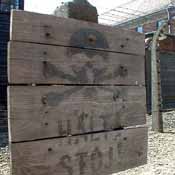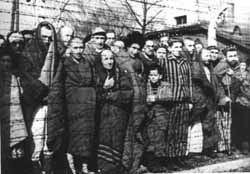The Establishment of Auschwitz
All over the world, Auschwitz has become a symbol of terror, genocide, and the Holocaust. It was established by the Nazis in 1940, in the suburbs of Oswiecim, a Polish city that was annexed to the Third Reich by the Nazis. Its name was changed to Auschwitz, which also became the name of Konzentrationslager Auschwitz. The camp was established in mid-1940, more than a year before the Germans embarked upon the "Endl?sung der Judenfrage" (Final Solution of the Jewish Question) - the plan, systematically carried out, to murder all the Jews living in the countries occupied by the Third Reich. The direct reason for the establishment of the camp was the fact that mass arrests of Poles were increasing beyond the capacity of existing "local" prisons. Initially, Auschwitz was to be one more concentration camp of the type that the Nazis had been setting up since the early 1930s. It functioned in this role throughout its existence, even when, beginning in 1942, it also became the largest of the death camps.
The Expansion of the Camp
The location of the camp, practically in the center of German-occupied Europe, and its convenient transportation connections, led the Nazis to expand Auschwitz on an enormous scale and deport people here from almost all of Europe. At its peak, the camp was composed of three parts:
The first and oldest was the so-called "main camp," later also known as "Auschwitz I" (the number of prisoners fluctuated around 15,000, sometimes rising above 20,000), which was established on the grounds and in the buildings of prewar Polish barracks;
The second part was the Birkenau camp (which held over 90,000 prisoners in 1944), also known as "Auschwitz II" This was the largest part of the Auschwitz complex. The Nazis began building it in 1941 on the site of the village of Brzezinka, three kilometers from Oswiecim. The Polish civilian population was evicted and their houses confiscated and demolished. The greater part of the apparatus of mass extermination was built in Birkenau and the majority of the victims were murdered here;
More than 40 sub-camps, exploiting the prisoners as slave laborers, were founded, mainly at various sorts of German industrial plants and farms, between 1942 and 1944. The largest of them was called Buna (Monowitz, with ten thousand prisoners) and was opened by the camp administration in 1942 on the grounds of the Buna-Werke synthetic rubber and fuel plant six kilometers from the Auschwitz camp. The factory was built during the war by the German IG Farbenindustrie cartel, and the SS supplied prisoner labor. On November 1943, the Buna sub-camp became the seat of the commandant of the third part of the camp, Auschwitz III, to which some other Auschwitz sub-camps were subordinated.
 The Germans isolated all the camps and sub-camps from the outside world and surrounded them with barbed wire fencing. All contact with the outside world was forbidden. However, the area administered by the commandant and patrolled by the SS camp garrison went beyond the grounds enclosed by barbed wire. It included an additional area of approximately 40 square kilometers (the so-called "Interessengebiet" - the interest zone), which lay around the Auschwitz I and Auschwitz II-Birkenau camps.
The Germans isolated all the camps and sub-camps from the outside world and surrounded them with barbed wire fencing. All contact with the outside world was forbidden. However, the area administered by the commandant and patrolled by the SS camp garrison went beyond the grounds enclosed by barbed wire. It included an additional area of approximately 40 square kilometers (the so-called "Interessengebiet" - the interest zone), which lay around the Auschwitz I and Auschwitz II-Birkenau camps.
The local population, the Poles and Jews living near the newly-founded camp, were evicted in 1940-1941. Approximately one thousand of their homes were demolished. Other buildings were assigned to officers and non-commissioned officers from the camp SS garrison, who sometimes came here with their whole families. The pre-war industrial facilities in the zone, taken over by Germans, were expanded in some cases and, in others, demolished to make way for new plants associated with the military requirements of the Third Reich. The camp administration used the zone around the camp for auxiliary camp technical support, workshops, storage, offices, and barracks for the SS.
The Number and Origins of the Victims
Auschwitz functioned throughout its existence as a concentration camp, and over time became the largest such Nazi camp. In the first period of the existence of the camp, it was primarily Poles who were sent here by the German occupation authorities. These were people regarded as particularly dangerous: the elite of the Polish people, their political, civic, and spiritual leaders, members of the intelligentsia, cultural and scientific figures, and also members of the resistance movement, officers, and so on. Over time, the Nazis also began to send groups of prisoners from other occupied countries to Auschwitz. Beginning in 1942, Jews whom the SS physicians classified as fit for labor were also registered in the camp. From among all the people deported to Auschwitz, approximately 400,000 people were registered and placed in the camp and its sub-camps (200,000 Jews, more than 140,000 Poles, approximately 20,000 Gypsies from various countries, more than 10,000 Soviet prisoners of war, and more than 10,000 prisoners of other nationalities). Over 50% of the registered prisoners died as a result of starvation, labor that exceeded their physical capacity, the terror that raged in the camp, executions, the inhuman living conditions, disease and epidemics, punishment, torture, and criminal medical experiments.
 Beginning in 1942, Auschwitz began to function in another way. It became the center of the mass destruction of the European Jews. The Nazis marked all the Jews living in Europe for total extermination, regardless of their age, sex, occupation, citizenship, or political views. They died only because they were Jews. After the selections conducted on the railroad platform, or ramp, newly arrived persons classified by the SS physicians as unfit for labor were sent to the gas chambers: the ill, the elderly, pregnant women, children. In most cases, 70-75% of each transport was sent to immediate death. These people were not entered in the camp records; that is, they received no serial numbers and were not registered. This is why it is possible only to estimate the total number of victims.
Beginning in 1942, Auschwitz began to function in another way. It became the center of the mass destruction of the European Jews. The Nazis marked all the Jews living in Europe for total extermination, regardless of their age, sex, occupation, citizenship, or political views. They died only because they were Jews. After the selections conducted on the railroad platform, or ramp, newly arrived persons classified by the SS physicians as unfit for labor were sent to the gas chambers: the ill, the elderly, pregnant women, children. In most cases, 70-75% of each transport was sent to immediate death. These people were not entered in the camp records; that is, they received no serial numbers and were not registered. This is why it is possible only to estimate the total number of victims.
Historians estimate that among the people sent to Auschwitz there were at least 1,100,000 Jews from all the countries of occupied Europe, over 140,000 Poles (mostly political prisoners), approximately 20,000 Gypsies from several European countries, over 10,000 Soviet prisoners of war, and over ten thousand prisoners of other nationalities. The majority of the Jewish deportees died in the gas chambers immediately after arrival.
The overall number of victims of Auschwitz in the years 1940-1945 is estimated at between 1,100,000 and 1,500,000 people. The majority of them, and above all the mass transports of Jews who arrived beginning in 1942, died in the gas chambers.
The Liberation of the Camp
 At the end of 1944, in the face of the approaching Red Army offensive, the Auschwitz administration set about removing the traces of the crimes that they had committed. They destroyed documents, dismantled some buildings, and burned others down or demolished them with explosives. The orders for the final evacuation and liquidation of the camp were issued in mid-January 1945.
At the end of 1944, in the face of the approaching Red Army offensive, the Auschwitz administration set about removing the traces of the crimes that they had committed. They destroyed documents, dismantled some buildings, and burned others down or demolished them with explosives. The orders for the final evacuation and liquidation of the camp were issued in mid-January 1945.
Prisoners capable of marching were evacuated into the depths of the Third Reich in late January 1945, at the moment when Soviet soldiers were liberating Cracow, some 60 kilometers from the camp. Approximately 56,000 men and women prisoners were led out of Auschwitz from January 17-21 in marching columns escorted by heavily armed SS guards. Many prisoners lost their lives during this tragic evacuation, known as the "Death March." On January 27, 1945, Red Army soldiers liberated the few thousand prisoners whom the Germans had left behind in the camp.
Source: The State Museum of Auschwitz-Birkenau. Reprinted with permission.


